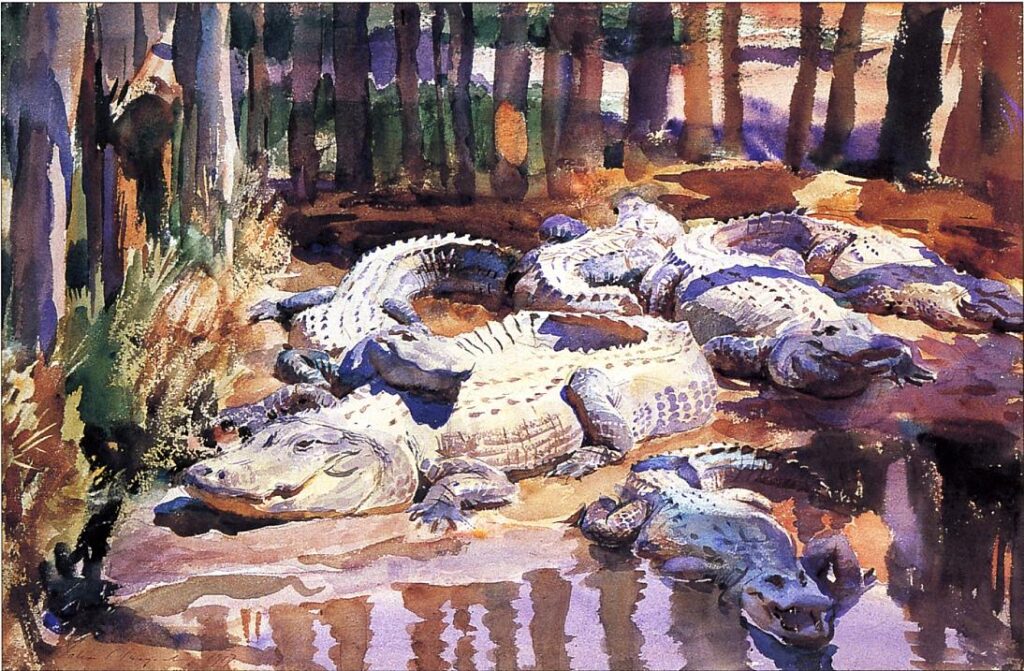Commemorating the centenary of John Singer Sargent’s death: 5 War

During the second decade of the twentieth century, John Singer Sargent continued his travels through Europe and in the USA. He painted some notable portraits of Americans, and progressed series of large murals in the Boston area of Massachusetts.
John Singer Sargent (1856-1925), Bringing Down Marble from the Quarries in Carrara (1911), oil on canvas, 71.5 x 91.8 cm, Metropolitan Museum of Art, New York, NY. WikiArt.
His larger oil paintings from this period often show finer details, that were almost certainly developed later in the studio. But even in those he retained a distinct painterliness, as shown in this view of workers Bringing Down Marble from the Quarries in Carrara which Sargent painted in 1911. These marble quarries in the north of Tuscany, Italy, provided most of the fine white and blue-grey marble for classical Roman buildings and statuary, and that for Michelangelo’s famous statue of David in 1501-04.
John Singer Sargent (1856–1925), In the Generalife (1912), watercolour and graphite on paper, 37.5 x 45.4 cm, The Metropolitan Museum of Art, New York, NY. Wikimedia Commons.
One of Sargent’s frequent companions during these travels was his sister, Emily, who was also a keen artist. In the Generalife (1912) shows her sketching in the gardens of the Generalife in Granada, Spain. She’s using a low metal easel with telescopic legs, and kneels sideways to work at it. Behind her is his friend Jane de Glehn, and to the right is a Spanish friend known only as Dolores. The unusual highlight effect seen in bushes above them, and on parts of the ground, was produced by scribbling with a colourless beeswax crayon, which resists the watercolour paint.
John Singer Sargent (1856-1925), Hospital at Granada (1912), oil on canvas, 55.9 x 71.1 cm, National Gallery of Victoria, Melbourne, Australia. The Athenaeum.
His oil painting of this Hospital at Granada from the same year shows the sick scattered haphazardly outside the wards and clinics, apparently awaiting medical attention.
John Singer Sargent (1856-1925), San Vigilio, Lake Garda (1913), oil on canvas, 72.1 x 183.8 cm, Lord Beaverbrook Art Gallery, New Brunswick, Canada. WikiArt.
The following year, Sargent visited Italy’s largest lake, at the southern edge of the Italian Alps, where he painted this tiny harbour of San Vigilio, Lake Garda, with its intricate broken reflections and underwater details.
John Singer Sargent (1856-1925), An Artist at His Easel (1914), watercolour over pencil on paper, 40 x 53.3 cm, The Art Institute of Chicago, Chicago, IL. The Athenaeum.
In the summer of 1914, Sargent was back in the cooler mountain air of the Alpine passes, this time in the company of the British artist Adrian Stokes (1854–1935) and his equally talented Austrian wife Marianne (1855-1927).
John Singer Sargent (1856–1925), The Master and His Pupils (1914), oil on canvas, 55.9 x 71.1 cm, Museum of Fine Arts Boston, Boston, MA. Wikimedia Commons.
The Master and His Pupils (1914) shows Adrian Stokes and Sargent’s sister Emily engaged in a painting lesson in the Alps.
John Singer Sargent (1856–1925), The Sketchers (1914), oil on canvas, dimensions not known, Virginia Museum of Fine Arts, Richmond, VA. Wikimedia Commons.
The Sketchers (1914) shows another artistic couple, probably the de Glehns or the Stokes, painting en plein air.
Sargent travelled through much of the summer of that year, and by July had reached Austria in the company of Adrian and Marianne Stokes. When the First World War broke out at the end of that month, they found themselves in a country that was suddenly at war with Britain. The Austrian authorities forbade them from leaving the country, but by the middle of December they had managed to reach Switzerland, from where they were able to return home safely.
John Singer Sargent (1856-1925), Muddy Alligators (1917), watercolour and graphite on paper, 35.5 x 53 cm, Worcester Art Museum, Worcester, MA. WikiArt.
Sargent spent the latter part of the First World War in the USA, where he painted this magnificent watercolour of Muddy Alligators (1917) when staying on the Miami estate of James Deering, whose wealth came from farm machinery.
John Singer Sargent (1856—1925), Crashed Aeroplane (1918), further details not known. Wikimedia Commons.
When he returned to Britain in 1918, Sargent was commissioned as a British War Artist. One of the most famous paintings of aviation during that war is his Crashed Aeroplane (1918). While two farmers get on with their harvest, there’s a crashed British biplane planted in the hillside behind.
John Singer Sargent (1856-1925), Interior of a Hospital Tent (1918), watercolour over pencil on paper, 39.4 x 52.7 cm, Imperial War Museums, London. The Athenaeum.
Sargent went on to paint scenes in military medical facilities, including this watercolour of the Interior of a Hospital Tent in 1918. Although makeshift and temporary, this appears more orderly and modern than that hospital in Granada.




